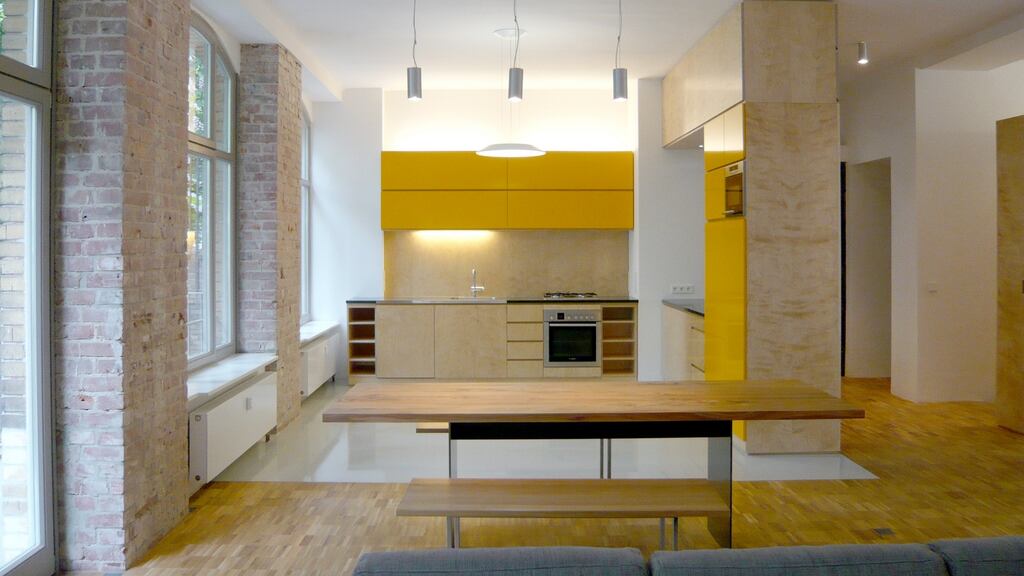Between cost-conscious builders and cautious planners Dublin’s new homes landscape doesn’t offer too many design highlights right now.
But as housebuilding gathers pace, new ideas are beginning to emerge, and there’s plenty of inspiration from abroad, particularly from London where Irish firm Ballymore is leading the way in city developments.
Here’s the best of the new trends, and although for now some are still stymied by Irish planning and building regulations, with demand as high as it is perhaps it is time to rethink the rulebook.
Cool customisation
House is an idea by Manchester-based Urban Splash Development, a company that has transformed the look and feel of Greater Manchester with its edgy fit-outs. Now it’s allowing new home owners in on the planning process. House allows you to customise the floor space you buy to the way you want to live. You decide the number of floors you want and how you want to live within a particular size space: living room upstairs or downstairs, open plan or small-scale nook layout. Tailor-made in a factory in Nottingham the homes are ready to live in in just three months.
"It's about offering the Grand Designs process to those who don't have the deep pockets or time to invest in a one-off property," says Simon Gawthorpe of Urban Splash, who would love to collaborate with Irish developers on a scheme here. Each of the 120 houses delivered to date in the UK has its own garden but the latest development in Newcastle, where prices start from £285,000 (€334,000), also boasts a communal garden – another growing trend.
Urbansplash.co.uk
Extend as you go
Homes that can be extended as your family and/or finances grow are what buyers, developers and planners want, says John O’Mahony of O’Mahony Pike Architects who designed Grace Park Wood, a development by Castlethorn Construction in Drumcondra, Dublin 9. Buyers have the option of adding an extra room – an 8sq m den – to the back of the three-bedroom terraced houses for an additional €35,000. Phase two of City West Village, comprising three and four-beds and set for launch in the autumn, is just one of the many new-builds offering convertible attic space so owners can extend up when they need to. All these add-ons allow families to stay put and put down roots, creating a greater sense of home.

Communal spaces
Sean Mulryan’s Ballymore Group has lead the way in creating environments in which to live, work, visit and spend time. Instead of waiting for a commercial tenant to set up shop at its new London City Island development it installed The Island Grocer, its own Italian deli and restaurant, so that from phase one residents would have a place to go. It doubles as a community hub for residents reviving the tradition of the local shop where customers were able to pick up a pint of milk or bag of groceries, enjoy a cup of coffee, a pint of beer or a bite to eat, all under the same roof, explains Hayleigh O’Farrell, head of communications, who lives there. She says it gives the place an energy from day one. There’s also an arts club, concierge service, games room and lounge area, gym and striking red outdoor swimming pool with a programme of events throughout the year that have included film screenings and an Easter egg painting workshop for families. “For me it allows me to have an active social life without ever having to leave home.”
Ballymoregroup.com
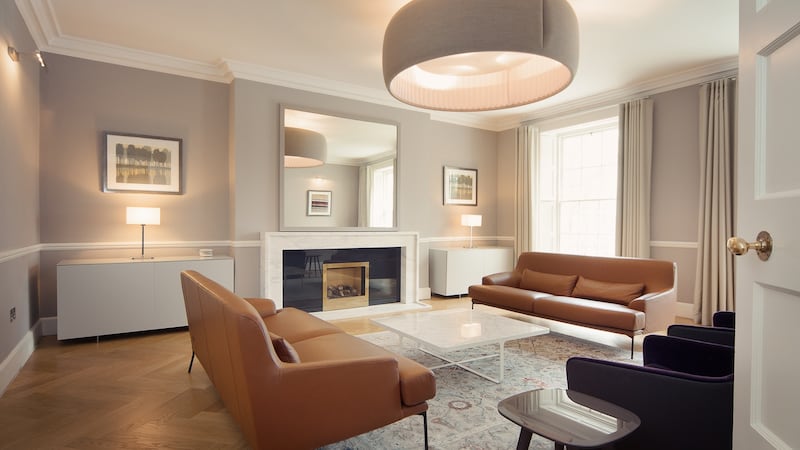
Party time
Cairn Homes is one of the Dublin-based developers adopting this model in its upcoming Marianella development in Rathgar, Dublin 6 where there will be a gym, function room and screening room so you can hang out at home but not in your house or apartment. Other firms are looking at communal roof terraces, barbecue pits for groups and even sunbathing decks.
By including similar on-site facilities Kennedy Wilson transformed Dublin’s rental scene with its offer of cool communal spaces to tenants. They include party rooms that residents can hire to host a get-together, a screening room, communal working areas, as well as gyms and a post room so you don’t have to spend your free time schlepping to the post office to pick up online purchases.
cairnhomes.com; Kennedywilson.com
All together now
Take a leaf from Berlin’s book where purchasers are encouraged to club together to buy and develop commercial premises into live/work homes. An Irish firm, Bucholz McEvoy Architects, which has a base in Berlin, recently worked on the refurbishment of an apartment in a former paper factory that was purchased under a scheme by the city council that demanded the spaces within it be used for both residents’ work and accommodation. “There was a mechanism in place for the five or six homeowners to buy the building together, to pay for the cost of the renovations and to then employ someone to refurbish each of their own spaces within the building,” explains Merritt Bucholz whose work in Ireland includes the Elm Park development near Merrion Gates. “The buyers also had to agree not to flip the properties and to live there as owner-occupiers.”
The result speaks for itself. His client’s 150sq m loft has a large open-plan living-kitchen-dining area with yellow laminated MDF units and green stone countertops. A big sliding door separates the bathroom from the rest of the loft. The large work area is separate from the living space and features large linoleum-topped trestle desks complete with office cabling which has been concealed behind aluminium sheet shelving. Bmcea.com
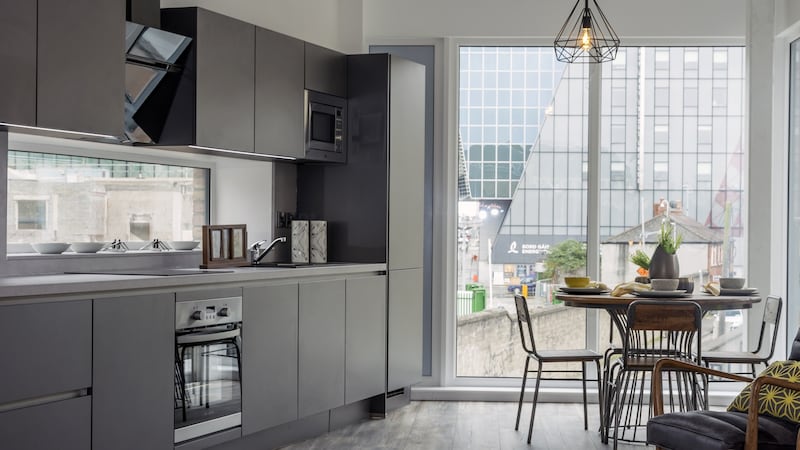
Kitchens man up
Kitchen units are getting darker and designs are getting sleeker to appeal to cooks of all sexes. Think handle-free units with streamlined countertops in light-reflecting whites, Calcatta-style marbles and stone composites being some of the most popular finishes. Eco Interiors designed the kitchens at Hannover Lofts, a scheme of 15 units in Dublin’s docklands that recently sold out on its launch weekend. The matte-finish concrete look design featured a manly taconite charcoal-coloured sink and strip LED lighting that you can change from cool to warm white depending on your mood or the time of day. “We wanted a design that wasn’t too overbearing and that could double as a bar counter for when you have friends over,” explains developer Mark Congrave of The Dublin Loft Company. Aloco Kitchens on Church Road in Dublin’s East Wall is a hidden showroom with some affordable matte lacquer handle-free door options on view on its upper floor level. Just don’t let the more traditional designs at entrance level put you off. Prices start from about €5,000, excluding internals and counters. Ecointeriors.ie; Alocokitchens.ie
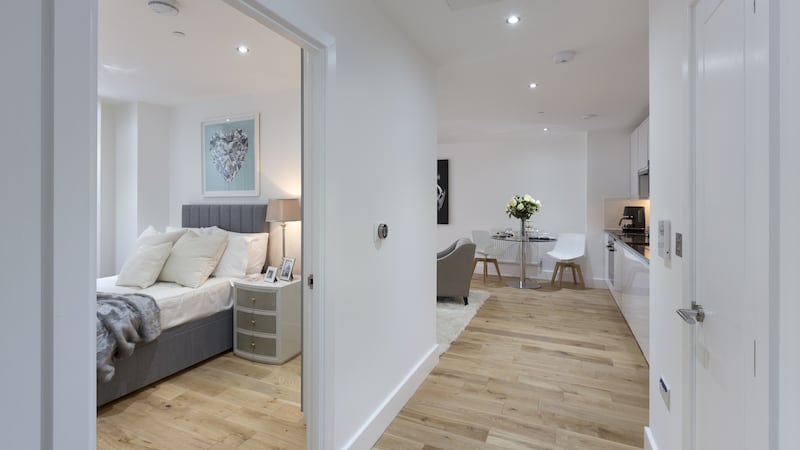
Micro living
Long accepted in Japan, the concept of living in very small spaces has yet to make its way here, but pressure on city sites could see it emerging in the next decade. In the UK, property developer Martin Skinner’s Inspired Homes has jumped into a gap in the UK’s planning laws to offer units that are 20 per cent more affordable than standard new builds because they are smaller than standard.
There, “micro-living” is allowed under what is called Permitted Development Rights which allows for certain types of work to be carried out on existing buildings without the need to apply for planning permission for a change of use. Inspired Homes has reimagined old redundant office stock as apartment blocks. The company’s one-bedroom properties measure from 30-37sq m, rather than the minimum 45sq m required by Irish planning law for new-builds. Two-bedroom units are 40-45sq m in size rather than the 63sq m required by law here.
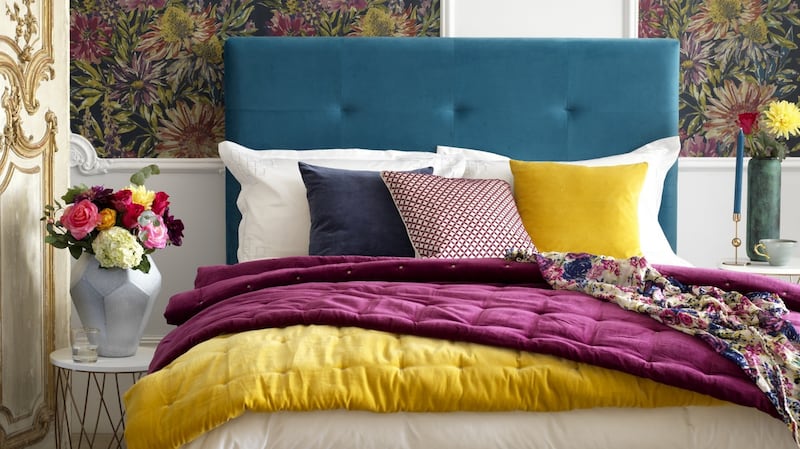
The residences have no hallways which shaves a few metres off their size and instead of a utility room there’s a laundry cupboard housing a washer and drier, one stacked on top of the other. Bedrooms are typically 9-10sq m – enough for a double bed, bedside table and wardrobe but no chest of drawers. “By making the private spaces smaller we can make home ownership more affordable. Where we have shared spaces, such as club lounges and sky gardens, residents are able to hang out, get to know each other and build communities,” Skinner says. Inspiredhomes.uk.com

Bathrooms big up
Bathrooms have been bigged up, with many new builds boasting natural light and ventilation from a window to make them feel more airy. Colour is also beginning to creep into a space that for many years seemed antiseptically bland. Niches, tiled waterproof shelving designed to hold shampoo and soap, have become a welcome addition to many new builds with many lit from within to offer an ambient mood in the washroom – lovely if you want to luxuriate in the bath. Neptune House in Blackrock, Co Dublin is one development featuring this lovely and easy-to-replicate idea. Capitol Dock, a rental scheme by Kennedy Wilson, will feature sleek units as well as cool mosaic tiling, says supplier Jurgen Riedel of BathSystem, who sells pre-fabricated pods that are dropped, fully-formed, into the build.

The return of colour
While design magazines have heralded the return of colour for several seasons now house-builders have erred on the side of caution and stuck with 50 shades of grey. One architect suggested that the reason for this was that the interiors were being designed for the parents purchasing, the bank of mam and dad, rather than for those who will end up living in the homes. But colour is creeping in. Recently designer Helen Turkington painted the whole library of a house in Knockrabo a deep and seductive shade of magenta called Florrie’s Pink, a colour from her own paint range; while showhouse designer Arlene McIntyre weaves colour into bedrooms using rich jewel shades in the headboards and bedspreads and cushions. Pictured is Iris, a teal bed frame from Button & Spring. Buttonandsprung.com
Four trends we’re glad to see the back of
(and what to do if you own one )
1. Timber decking
Whole forests of trees lost their lives to the timber deck phenomenon. Every DIYer in the country transformed their outdoor space, no matter its size or orientation, into an outside room, and then promptly forgot about it leaving it to fade to grey, rot and become a slip hazard.
What to do: Tear it out and replace with wood-look ridged ceramic tiles that look like warm-stained decking but need far less maintenance. In sunspots they also retain the heat with some savvy homeowners installing electric underfloor heating to keep it warm after dark.
2. Polished black granite countertops
The masculine dark polished countertops of the boom have been found to show up every speck of dust as well as drinking light from even the brightest of spaces.
What to do: Repurpose as cool shelving in a den or use as a fire surround instead of slate.
3. That vanilla gloss kitchen
For a while there you couldn’t cross the threshold of a new development without coming into contact with high shine vanilla gloss units with matching gleaming worktops. With fashions in kitchens changing every five years these now feel tired.
What to do: Either replace the doors with a more fashionable matte in a sludgy colour or dilute the all-cream look with new coloured counter-tops – pale pinks or blues will bring it bang up to date.
4. Dividing doors between livingroom and diningroom
This arrangement harked back to the rare old times when one big draughty room could be cut off from another by high folding doors. The need is not so acute in well-insulated contemporary homes where the doors are likely to the be either permanently open or closed.
What to do: Consider removing the doors altogether, along with the fittings. Smooth down paintwork, repaint and let the two rooms flow into each other. Back-to-back sofas, or a sofa with a table aligned at its back work well as room dividers instead.
